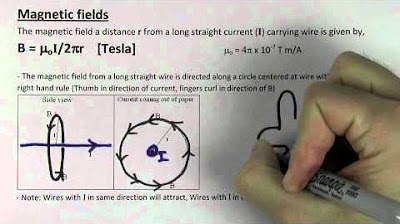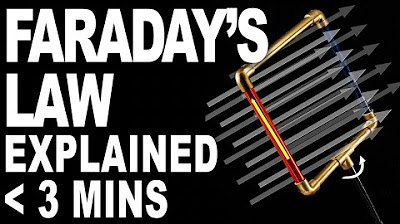Induced EMF In Moving Conductor, Sliding Bar Generator - Faraday's Law of Electromagnetic Induction
TLDRThis video script discusses the calculation of induced electromotive force (emf) in a circuit with a moving rod in a magnetic field. It covers the formula for induced emf, the calculation of current, electric field in the rod, energy dissipated by a resistor, and the force needed to move the rod. The explanation involves principles of electromagnetism and Ohm's law.
Takeaways
- 🔋 The induced electromotive force (emf) in a circuit can be calculated using Faraday's law of electromagnetic induction, which is the negative change in magnetic flux over time.
- 🌀 In the given scenario, the magnetic field strength and the number of loops are constants, with the change in flux being due to the movement of the rod.
- 📏 The length of the rod and its speed of movement are crucial in determining the change in the enclosed area and, consequently, the induced emf.
- 🧲 The angle between the magnetic field and the normal to the face of the coil is zero degrees, simplifying the calculation of flux as the magnetic field is parallel to the normal line.
- ⚡ The induced emf is calculated as the product of the magnetic field strength, the length of the rod, and the speed of the rod, resulting in 5 volts.
- 🔌 The current in the circuit is found by dividing the induced emf by the resistance of the resistor, yielding a current of 0.5 amps or 500 milliamps.
- 🛠 The electric field in the rod is determined by dividing the induced emf by the length of the rod, resulting in a field strength of 10 volts per meter.
- ⏱ The energy dissipated by the resistor over time can be calculated using the formula for power (voltage times current) and then multiplying by time, resulting in 12.5 joules after 5 seconds.
- 🔧 The force needed to pull the rod against the magnetic force can be found by equating the work done (energy dissipated by the resistor) to the force times displacement.
- 🔄 The work done by the force moving the rod is equal to the energy transferred from mechanical to electrical and then to heat energy in the resistor.
- ⚖️ The force required to move the rod is equal to the product of the current, the length of the rod, and the magnetic field strength, which is calculated to be 1.25 newtons.
Q & A
What is the formula for calculating the induced electromotive force (emf) in the given scenario?
-The formula for the induced emf is the change in magnetic flux divided by the change in time, represented as \( \text{Induced EMF} = -\frac{\Delta \Phi}{\Delta t} \), where the negative sign indicates the direction of the induced emf according to Lenz's law.
Why is the number of loops (n) considered to be one in this scenario?
-In this scenario, there is only a single loop involved in the circuit, so the number of turns (n) is one, simplifying the calculation of induced emf without the need to multiply by n.
How does the angle between the magnetic field and the normal line of the coil affect the calculation of flux?
-The angle affects the calculation through the cosine term in the flux formula. Since the magnetic field is parallel to the normal line of the coil, the angle (theta) is 0 degrees, and cosine of 0 is 1, which simplifies the flux calculation to \( \Phi = B \times \Delta A \).
What is the relationship between the horizontal displacement (delta x) and the velocity (v) of the rod?
-The horizontal displacement (delta x) is equal to the velocity (v) of the rod multiplied by the change in time (delta t), represented as \( \Delta x = v \times \Delta t \).
How is the area change (delta A) related to the length of the rod (l) and its horizontal displacement?
-The area change (delta A) is the product of the length of the rod (l) and its horizontal displacement (delta x), which simplifies to \( \Delta A = l \times \Delta x \) after canceling out delta t.
What is the calculated induced emf when the magnetic field is 5 Tesla, the rod's length is 0.5 meters, and the rod moves at 2 meters per second?
-The induced emf is calculated as \( 5 \, \text{Tesla} \times 0.5 \, \text{meters} \times 2 \, \text{meters/second} = 5 \, \text{Volts} \).
How is the current in the circuit determined after the induced emf is known?
-The current in the circuit is determined by dividing the induced emf by the resistance of the circuit, represented as \( \text{Current} = \frac{\text{Induced EMF}}{\text{Resistance}} \), which in this case is \( \frac{5 \, \text{Volts}}{10 \, \Omega} = 0.5 \, \text{Amps} \) or 500 milliamps.
What is the formula to calculate the electric field (E) in the rod?
-The electric field (E) in the rod is calculated by dividing the induced emf across the rod by the length of the rod, represented as \( E = \frac{\text{Induced EMF}}{\text{Length of the rod}} \), which gives \( \frac{5 \, \text{Volts}}{0.5 \, \text{meters}} = 10 \, \text{Volts/meter} \).
How is the energy dissipated by the resistor calculated after five seconds?
-The energy dissipated by the resistor is calculated by multiplying the induced emf by the current flowing through the resistor and the time, represented as \( \text{Energy} = \text{Induced EMF} \times \text{Current} \times \text{Time} \), which gives \( 5 \, \text{Volts} \times 0.5 \, \text{Amps} \times 5 \, \text{Seconds} = 12.5 \, \text{Joules} \).
What is the relationship between the force needed to pull the rod and the magnetic force exerted on it?
-The force needed to pull the rod is equal to or greater than the magnetic force exerted on it due to the current flowing through the rod in the presence of the magnetic field. The magnetic force can be calculated as \( \text{Force} = i \times l \times B \), where i is the current, l is the length of the rod, and B is the magnetic field strength.
Outlines
🔋 Induced EMF and Circuit Analysis
This paragraph explains the process of calculating the induced electromotive force (EMF) in a circuit with a moving rod within a magnetic field. The rod, 0.5 meters long, moves at 2 meters per second to the right and is in a 5-tesla magnetic field. The formula for induced EMF is discussed, considering the change in magnetic flux over time. The calculation simplifies due to the parallel orientation of the rod and the magnetic field, leading to an induced EMF of 5 volts. The current through a 10-ohm resistor is then calculated to be 0.5 amps or 500 milliamps. The electric field in the rod is determined to be 10 volts per meter by dividing the induced EMF by the rod's length.
💡 Energy Dissipation and Force Calculation
The second paragraph delves into the energy dissipation by a resistor over a period of five seconds and the force required to maintain the rod's motion. The energy dissipated by the resistor is calculated using the formula for power (voltage times current) and time, resulting in 12.5 joules. The force needed to pull the rod is then determined by equating the work done (energy transferred to the resistor) with the force times displacement. The work done by the force is found to be equivalent to the energy dissipated by the resistor, assuming an ideal situation with no energy loss. The force required to move the rod against the magnetic force is calculated using the formula ilB, where i is the current, l is the length of the rod, and B is the magnetic field strength, resulting in a force of 1.25 newtons. The displacement of the rod is also calculated to be 10 meters, confirming the force required.
📐 Force Verification Through Work and Displacement
The final paragraph verifies the force needed to pull the rod by using the work done and the displacement of the rod. It reiterates the work done by the force, which is 12.5 joules, and divides this by the displacement of 10 meters to confirm the force of 1.25 newtons. This method provides an alternative verification of the force required to move the rod within the magnetic field and circuit setup previously described.
Mindmap
Keywords
💡Induced EMF
💡Magnetic Field
💡Flux
💡Resistor
💡Ohm
💡Cosine Theta
💡Electric Field
💡Energy Dissipation
💡Work
💡Magnetic Force
Highlights
A moving rod with a length of 0.5 meters slides to the right at a speed of 2 meters per second in a magnetic field of 5 tesla.
The metal rails are connected to a 10-ohm resistor to calculate the induced emf in the circuit.
The induced emf is calculated using the formula involving the change in flux over time, with a negative sign and a loop count of one.
The enclosed area changes as the rod moves, affecting the flux, which is calculated as B times the change in area.
The angle between the coil's normal line and the magnetic field is zero degrees, simplifying the cosine term to one.
The area change is the product of the rod's length and its horizontal displacement, which is velocity times time.
The induced emf is derived as the product of the magnetic field, rod length, and rod's speed.
The induced emf in the example is calculated to be 5 volts, considering the given parameters.
The current in the circuit is calculated by dividing the induced emf by the resistance, resulting in 0.5 amps.
The electric field in the rod is determined by dividing the induced emf by the rod's length, yielding 10 volts per meter.
Energy dissipated by the resistor after five seconds is calculated using the formula power times time, resulting in 12.5 joules.
The force needed to pull the rod to the right is derived from the work done by the force, which equals the energy dissipated by the resistor.
The force is calculated to be 1.25 newtons, considering the current, rod length, and magnetic field strength.
The displacement of the rod is determined by multiplying the velocity by the time, resulting in 10 meters.
The force required to move the rod is confirmed by dividing the work done by the displacement, aligning with the previous calculation.
The analysis demonstrates the relationship between mechanical energy, electrical energy, and heat energy in the context of a moving conductor in a magnetic field.
The calculations provide insights into the principles of electromagnetic induction and its practical applications in electrical circuits.
Transcripts
Browse More Related Video

Faraday's Law of Electromagnetic Induction, Magnetic Flux & Induced EMF - Physics & Electromagnetism

11. Lenz's and Faraday's Laws

AP Physics B 2013 Question 6 - Electromagnetism

Lenz's Law, Right Hand Rule, Induced Current, Electromagnetic Induction - Physics

Magnetic (AP Physics SuperCram Review)

Faradays Law in 3 minutes
5.0 / 5 (0 votes)
Thanks for rating: